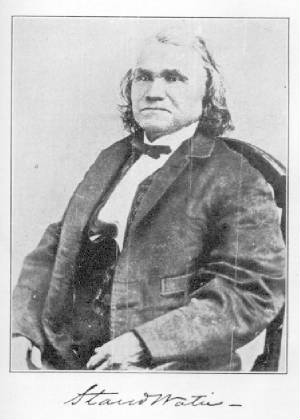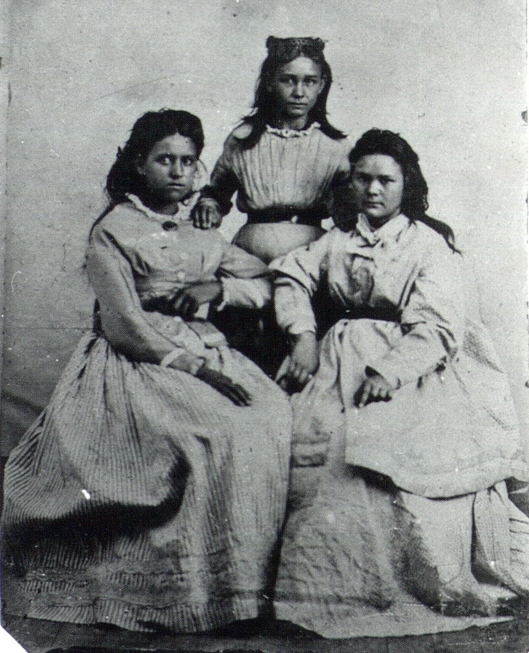|
Cherokee Chief Stand Watie Cherokee Nation Oklahoma and Indian Territory History
| Cherokee Chief and General Stand Watie |

|
| Stand Watie. Courtesy National Archives |
Born at Oothcaloga in the Cherokee Nation, Georgia (near present day Rome,
Georgia) on December 12, 1806, Stand Watie's Cherokee name was De-ga-ta-ga, or "he stands." He also was known as Isaac
S. Watie. He attended Moravian Mission School at Springplace Georgia, and served as a clerk of the Cherokee Supreme Court
and Speaker of the Cherokee National Council prior to removal.
(Right) Stand Watie (December
12, 1806 – September 9, 1871).
As a member of the Ridge-Watie-boundinot faction of the Cherokee Nation,
Watie supported removal to the Cherokee Nation, West, and signed the Treaty of New Echota in 1835, in defiance of Principal Chief John Ross and the majority of the Cherokees (see Cherokee Trail of Tears: A History). Watie moved to the Cherokee Nation, West (present-day Oklahoma), in 1837 and settled at Honey Creek. Following
the murders of his uncle Major Ridge, cousin John Ridge, and brother Elias Boundinot (Buck Watie) in 1839, and his brother
Thomas Watie in 1845, Stand Watie assumed the leadership of the Ridge-Watie-Boundinot faction and was involved in a long-running
blood feud with the followers of John Ross. He also was a leader of the Knights of the Golden Circle, which bitterly
opposed abolitionism.
At the outbreak of the Civil War, Watie quickly joined the Southern cause.
He was commissioned a colonel on July 12, 1861, and raised a regiment of Cherokees for service with the Confederate army. Later,
when Chief John Ross signed an alliance with the South, Watie's men were organized as the Cherokee Regiment of Mounted Rifles.
After Ross fled Indian Territory, Watie was elected principal chief of the Confederate Cherokees in August 1862.
| Daughters of Stand Watie |

|
| Daughters of General Stand Watie, c. 1870 |
A portion of Watie's command saw action at Oak Hills (August 10, 1861) in a battle that assured the South's
hold on Indian Territory and made Watie a Confederate military hero. Afterward, Watie helped drive the pro-Northern Indians
out of Indian Territory, and following the Battle of Chustenahlah (December 26, 1861) he commanded the pursuit of the fleeing
Federals, led by Opothleyahola, and drove them into exile in Kansas. Although Watie's men were exempt from service outside
Indian Territory, he led his troops into Arkansas in the spring of 1861 to stem a Federal invasion of the region. Joining
with Maj. Gen. Earl Van Dorn's command, Watie took part in the Battle of Elkhorn Tavern (March 5-6, 1861). On the first
day of fighting, the Southern Cherokees, which were on the left flank of the Confederate line, captured a battery of Union
artillery before being forced to abandon it. Following the Federal victory, Watie's command screened the southern withdrawal.
Watie, or troops in his command, participated in eighteen battles and major skirmishes with Federal troop
during the Civil War, including Cowskin Prairie (April 1862), Old Fort Wayne (October 1862), Webber's Falls (April 1863),
Fort Gibson (May 1863), Cabin Creek (July 1863), and Gunter's Prairie (August 1864). In addition, his men were engaged
in a multitude of smaller skirmishes and meeting engagements in Indian Territory and neighboring states. Because of his
wide-ranging raids behind Union lines, Watie tied down thousands of Federal troops that were badly needed in the East.
Watie's two greatest victories were the capture of the federal steam boat J.R. Williams on June 15, 1864,
and the seizure of $1.5 million worth of supplies in a federal wagon supply train a the Second battle of Cabin Creek on September
19, 1864. Watie was promoted to brigadier general on May 6, 1864, and given command of the first Indian Brigade. He
was the only Indian to achieve the rank of general in the Civil War. Watie surrendered on June 23, 1865, the last Confederate
general to lay down his arms.
After the war, Watie served as a member of the Southern Cherokee delegation during the negotiation of the
Cherokee Reconstruction Treaty of 1866. He then abandoned public life and returned to his old home along Honey Creek.
He died on September 9, 1871.
Source: Kenny A. Franks, The Confederacy, Macmillan Information
Now Encyclopedia; photo of Stand Watie courtesy National Archives; photo of Daughters is Image #16978 in the Stand Watie
Collection.
Recommended Reading: General Stand Watie's Confederate Indians
(University of Oklahoma Press). Description: American Indians were courted by both the North and the South prior to that
great and horrific conflict known as the American Civil War. This is the story of the highest ranking Native American--Cherokee
chief and Confederate general--Stand Watie, his Cherokee Fighting Unit, the Cherokee, and the conflict
in the West...
Related Reading:
Recommended Reading: Rifles for
Watie. Description: This is a rich and sweeping novel-rich in its panorama
of history; in its details so clear that the reader never doubts for a moment that he is there; in its dozens of different
people, each one fully realized and wholly recognizable. It is a story of a lesser -- known part of the Civil War, the Western
campaign, a part different in its issues and its problems, and fought with a different savagery. Inexorably it moves to a
dramatic climax, evoking a brilliant picture of a war and the men of both sides who fought in it.
Recommended
Reading: The
Blue, the Gray, and the Red: Indian Campaigns of the Civil War (Hardcover: 288 pages). Description: Inexperienced Union
and Confederate soldiers in the West waged numerous bloody campaigns against the Indians during the Civil War. Fighting with
a distinct geographical advantage, many tribes terrorized the territory from the Plains to the Pacific, as American pioneers
moved west in greater numbers. These noteworthy--and notorious--Indian campaigns featured a fascinating cast of colorful characters,
and were set against the wild, desolate, and untamed territories of the western United
States. This is the first book to explore Indian conflicts that took place during the Civil
War and documents both Union and Confederate encounters with hostile Indians blocking western
expansion. Continued below...
From
Publishers Weekly: Beginning with the flight
of the Creeks into Union territory pursued by Confederate forces (including many of Stand Watie's Cherokees), this popular
history recounts grim, bloody, lesser-known events of the Civil War. Hatch (Clashes
of the Cavalry) also describes the most incredible incidents.... Kit Carson, who fought Apaches and
Navajos under the iron-fisted Colonel Carleton, arranged the Long Walk of the Navajos that made him infamous in Navajo history
to this day. The North's "Captain" Woolsey, a volunteer soldier, became a brutal raider of the Apaches. General Sibley, a
northerner and first Governor of Minnesota, oversaw the response to the Sioux Uprising of 1862 that
left several hundred dead. The slaughter of Black Kettle's Cheyennes at Sand Creek in
1864 by Colorado volunteers under Colonel Chivington,
a militant abolitionist whose views on Indians were a great deal less charitable, “forms a devastating chapter.”
Hatch, a veteran of several books on the Indian Wars that focus on George Armstrong Custer, has added to this clear and even-handed
account a scholarly apparatus that adds considerably to its value.
Cherokee Chief Stand Waite Cherokee Nation Oklahoma History, Indian Territory Photo, Photos,
Picture, Photographs, Treaty of New Echota 1835, Trail of Tears of 1838, General Stand Watie Confederate Facts
|

